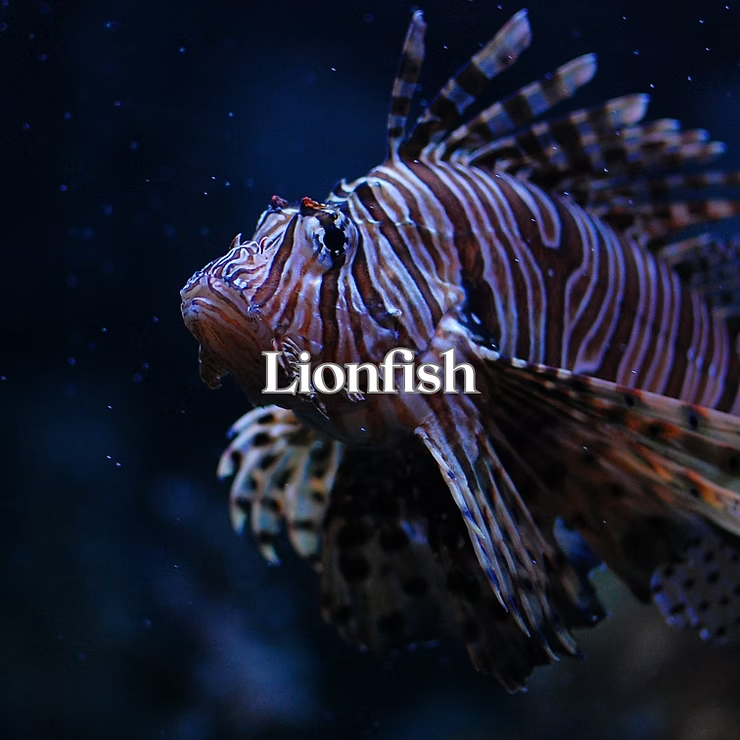The Fascinating yet Dangerous Lionfish
Lionfish are striking marine creatures admired for their beauty yet feared for their impact on ecosystems. Native to the Indo-Pacific, they have invaded the Atlantic and Caribbean, where their rapid reproduction and voracious appetite pose a serious threat to coral reefs and native fish species.
Key Takeaways
- Lionfish possess venomous spines that can cause painful stings to humans.
- They are invasive in the Atlantic and Caribbean, harming native marine life.
- Their vivid stripes act as a warning to predators.
- Lionfish thrive in tropical and subtropical waters, especially coral reefs.
- As ambush predators, they consume a wide variety of prey, disrupting ecosystems.
What Makes Lionfish Unique
Venomous Spines and Defense
Lionfish carry venomous spines along their dorsal, pelvic, and anal fins. A sting can cause severe pain, swelling, and in rare cases, more serious complications. When threatened, they flare their spines outward to appear larger and deter predators—a powerful survival tactic.
Invasive Species Status
Although native to the Indo-Pacific, lionfish spread into the Atlantic through aquarium releases. With no natural predators and the ability to reproduce quickly, their population exploded. This invasion reduces native fish numbers, weakens coral reefs, and destabilizes ecosystems. To address the crisis, communities host lionfish hunting derbies, encourage consumption of lionfish as seafood, and conduct ongoing monitoring programs.
Colorful Appearance
Adorned with bold red, orange, and white stripes, lionfish are visually captivating. Their flowing fins enhance their elegance while signaling danger to potential predators. Yet, this beauty hides the destructive reality of their invasive spread.
Habitat and Distribution
Tropical Waters and Coral Reefs
Lionfish prefer warm seas, thriving in coral reefs that offer both prey and shelter. Their presence in these delicate environments is devastating, as they prey on herbivorous fish crucial for reef health. Studies show lionfish can consume prey up to two-thirds their own size, amplifying their ecological impact.
Atlantic Expansion
In the Atlantic Ocean, lionfish populations continue to grow. Conservationists combat this spread through targeted fishing, research, and public education, but controlling their numbers remains an ongoing challenge.
Feeding Habits
Ambush Predators
Using stealth, lionfish trap prey with their wide pectoral fins before striking. Their diet includes fish, crustaceans, and occasionally smaller lionfish. Adaptability in feeding contributes to their dominance as invaders.
Impact on Ecosystems
By consuming juvenile and herbivorous fish, lionfish disrupt coral reef resilience and biodiversity. Their unchecked growth places them among the most harmful invasive species in marine environments.
Reproduction and Life Cycle
Lionfish reproduce at an extraordinary rate. Females release up to 30,000 eggs every few days, which drift on currents before hatching. Juveniles grow quickly, adopting camouflage until they mature. This rapid life cycle ensures their population expands relentlessly in non-native waters.
Control and Management
Hunting and Fishing
Spearfishing and trapping are widely used to reduce lionfish numbers. Divers are encouraged to catch and consume lionfish, which is considered safe and delicious once venomous spines are removed.
Research and Monitoring
Scientists study lionfish behavior, diet, and distribution to design effective management strategies. Monitoring population trends helps predict spread and guides targeted removal efforts.
Public Awareness
Educational campaigns highlight the dangers of lionfish and promote responsible fishing. Social media, community events, and school programs play a crucial role in engaging the public in conservation efforts.
Conclusion
Lionfish, though stunning in appearance, are a pressing ecological concern. Their venomous defenses, aggressive feeding, and rapid reproduction make them highly destructive in non-native habitats. Through collective efforts—hunting, research, and education—marine communities can help curb their impact and protect vulnerable ecosystems.
Frequently Asked Questions
What is a lionfish?
A venomous fish native to the Indo-Pacific but invasive in the Atlantic and Caribbean.
Why are they invasive?
Lionfish reproduce rapidly, lack natural predators, and outcompete native fish for resources.
What do lionfish eat?
They prey on small fish, crustaceans, and invertebrates, often consuming prey nearly their own size.
How do they affect ecosystems?
They reduce biodiversity, disrupt coral reef health, and dominate local food chains.
How are they controlled?
Through organized hunts, fishing initiatives, monitoring, and public awareness campaigns.

